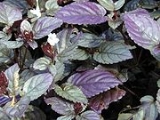
Strobilanthes
Encyclopedia
Strobilanthes is a genus of about 250 species of flowering plant
s in the family Acanthaceae
, mostly native to tropical Asia
, but with a few species extending north into temperate regions of Asia.
Selected species
 Strobilanthes atropurpureus is a temperate species, native to eastern Siberia
Strobilanthes atropurpureus is a temperate species, native to eastern Siberia
; it is cultivated for its purple flowers.
Strobilanthes dyerianus (Persian Shield) is a tropical plant native to Myanmar
. It is grown for its dark green foliage with bright, metallic-purple stripes radiating outward from the central leaf vein. In proper conditions, it will also produce pale purple flowers. Persian Shield grows best outdoors in USDA
zones 9 and 10, although it can survive in other zones as a houseplant given sufficient temperature, soil moisture and humidity.
Strobilanthes species are used as food plants by the larva
e of some Lepidoptera
species including Endoclita malabaracus
, which has been recorded on S. callosus.
Flowering plant
The flowering plants , also known as Angiospermae or Magnoliophyta, are the most diverse group of land plants. Angiosperms are seed-producing plants like the gymnosperms and can be distinguished from the gymnosperms by a series of synapomorphies...
s in the family Acanthaceae
Acanthaceae
The family Acanthaceae is a taxon of dicotyledonous flowering plants containing almost 250 genera and about 2500 species....
, mostly native to tropical Asia
Asia
Asia is the world's largest and most populous continent, located primarily in the eastern and northern hemispheres. It covers 8.7% of the Earth's total surface area and with approximately 3.879 billion people, it hosts 60% of the world's current human population...
, but with a few species extending north into temperate regions of Asia.
Selected species
|

Siberia
Siberia is an extensive region constituting almost all of Northern Asia. Comprising the central and eastern portion of the Russian Federation, it was part of the Soviet Union from its beginning, as its predecessor states, the Tsardom of Russia and the Russian Empire, conquered it during the 16th...
; it is cultivated for its purple flowers.
Strobilanthes dyerianus (Persian Shield) is a tropical plant native to Myanmar
Myanmar
Burma , officially the Republic of the Union of Myanmar , is a country in Southeast Asia. Burma is bordered by China on the northeast, Laos on the east, Thailand on the southeast, Bangladesh on the west, India on the northwest, the Bay of Bengal to the southwest, and the Andaman Sea on the south....
. It is grown for its dark green foliage with bright, metallic-purple stripes radiating outward from the central leaf vein. In proper conditions, it will also produce pale purple flowers. Persian Shield grows best outdoors in USDA
United States Department of Agriculture
The United States Department of Agriculture is the United States federal executive department responsible for developing and executing U.S. federal government policy on farming, agriculture, and food...
zones 9 and 10, although it can survive in other zones as a houseplant given sufficient temperature, soil moisture and humidity.
Strobilanthes species are used as food plants by the larva
Larva
A larva is a distinct juvenile form many animals undergo before metamorphosis into adults. Animals with indirect development such as insects, amphibians, or cnidarians typically have a larval phase of their life cycle...
e of some Lepidoptera
Lepidoptera
Lepidoptera is a large order of insects that includes moths and butterflies . It is one of the most widespread and widely recognizable insect orders in the world, encompassing moths and the three superfamilies of butterflies, skipper butterflies, and moth-butterflies...
species including Endoclita malabaracus
Endoclita
Endoclita is a genus of moths of the family Hepialidae. There are 60 described species found in eastern and southeast Asia and the Indian subcontinent.- Species :*E. aboe - India*E. absurdus - China*E. actinidae - China...
, which has been recorded on S. callosus.

